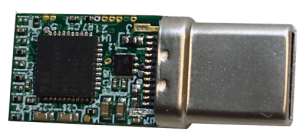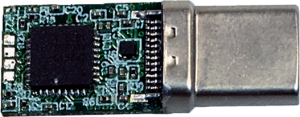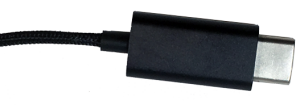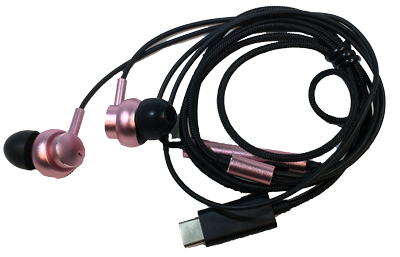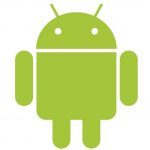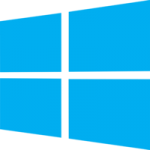The USB-C100 & USB-C101 USB “Type-C” Turn-key Modules – Complete Digital Audio Solutions Embedded inside a USB-C Connector
While nearly identical to the TDTSI010 USB-C (USB “Type-C”) dongle from a functional standpoint (sans GPIO-based buttons, integrated microphone, board size and cables), the USB-C100 / USB-C101 is Tempo’s USB-C Headphone / Headset / Female 3.5mm Adapter embedded connector complete turn-key module offering. This highly cost-effective solution is targeted at Android™ / Windows® / macOS® X / Linux® OS-powered mobile / desktop / laptop / tablet devices.
Unlike the legacy TDTSI0101 (predecessor to the USB-C100 / USB-C101 module) and the TDTSI016 turn-key reference designs which connects the USB to I2S Bridge IC via discrete GPIO signals to discrete push-buttons (removing the need for an additional PCB), the USB-C100 / USB-C101 turn-key modules enable ANY OEM or ODM to simply convert their current Android 3.5 mm Headset Specification-compliant product that employs a single push button (Function A) or 3 push buttons (Functions A, B & C) which are designed using the simple resistor-ladder network per the Android 3.5mm: Headset Accessory Specification.
The RoHS compliant USB-C100 / USB-C101 modules are the simplest and fastest time to market solution for OEMs or ODMs desiring to make a Headset product that is 100% Compliant to the Android USB Headset: Accessory Specification
The conversion process to USB Type-C from your current 3.5mm Headset is as simple as
1, 2, 3…
1.) Solder the 4 wires from a 3.5mm headset to the 4 pads on the end of the USB-C100 / C101 turn-key module, which follows the CTIA standard, from top pad to bottom pad as shown below. Conversely, if you are converting a 3.5mm headphone to be USB-C compatible, then only the Left, Right and Ground signals would be soldered to the module:
2.) Wrap USB-C100 / USB-C101 module and end of Headset wire connection in plastic / polymer / rubber / etc.
3.) Test, package, & ship your new USB-C Headset.
Just as an example, the picture of the below is of a pair of USB-C Android compliant Headsets were manufactured in only 4 days from the time the modules were supplied to the Headset ODM.
The ODM started out with a pair of 3.5mm jack Android compliant single dynamic driver Headsets that already employed the resistor ladder network using 3 buttons (Volume Up, Volume Down, Pause / Play)
It just doesn’t get any easier.
No firmware to develop.
No software to develop.
No app to develop.
Nothing to debug.
USB-C100 Turn-Key Module vs. USB-C101 Turn-Key Module
The USB-C100 and USB-C101 are electrically identical, however, the USB-C101 offers a different configuration of firmware that enables all of the various processing capabilities of the USB-C101 to be controlled via a customizable Android App.
Please contact sales@temposemi.com if you are interested in learning more about the USB-C100 / USB-C101 turn-key module or obtaining a sample of the USBC-100 or USB-C101 module free of charge.
What about the ability to flatten the frequency response of my Headset drivers after they have been put inside the enclosure?
With up to 24 independently configurable biquads (12 per ear), a triple band Compressor / Limiter / Expander with independent frequency and time domain adjustments, a wideband DRC, a psychoacoustic bass and treble enhancement, and a 3D stereo enhancement enables a standard 3.5mm Headset that might have had an MSRP of $9.99 ~ $14.99 due to the low cost of the drivers and/or enclosures to now be able to command a MUCH higher MSRP of 2x~10x thanks to the value that the TSCS25xx 32-bit premium audio codec with integrated DSP enables in addition to the convenience and performance that a USB-C enabled Headset brings.
These customized DSP register values can either be stored inside the complementary & customizable Android app and loaded into the respective Headsets OR a subset of these features can be pre-programmed into a FULLY customized version of the USB-C101 module prior to being enclosed in plastic – which is particularly useful if the OEM does not desire to require the consumer to first download an app before they can hear the factory tuned solution. (Note: Please contact the factory for more details on pricing, MOQ, leadtimes and terms for a customized module).
Will this module work with my USB-C Mobile Device?
If your mobile device has a DIGITAL AUDIO USB Type-C implementation, then yes.
If your mobile device as an ANALOG AUDIO USB Type-C implementation, no.
What USB-C Mobile Devices have been tested to work with this module?
The following is a partial list of the devices that are supported, but is inclusive of all of the devices we have tested:
Google Pixel, Google Pixel XL, Google Pixel 2, Google Pixel 2 XL, Sony Xperia XZ, LG V30, Samsung Galaxy Note 8, Samsung Galaxy S8, Samsung Galaxy S8+
All devices listed on the following website should work, but again, not all have been tested and hence cannot be guaranteed to work.
Are all four functions (A, D, B, C) possible using only 3 buttons without having Android 8.0?
Yes. You only need to enable functions A, B, C in your product.
Function D “Voice Assistant” is possible via a “Long Press” of the Function A button (Pause / Play), with Android 5.0 and later.
What versions of Android are supported with this module?
Android 5.0 and later.
What versions of mac OS are supported with this module?
10.x and later.
Will a long press of the Pause/Play button with this module bring up Siri?
Not at this time, however, the mic will still work so calling out “Siri” will bring up Siri if voice activation of Siri is enabled. This is subject to change.
What versions of Windows are supported with this module?
Windows XP and later.
Will a long press of the Pause/Play button with this module bring up Cortana?
Not at this time, however, the mic will still work so calling out “Cortana” will bring up Cortana. This is subject to change.
What versions of Linux are supported with this module?
Most Linux distributions (Kernel 2.74) and later.
Documents
| Title | Type | Format | File Size | Post Date | File Date / Version |
|---|---|---|---|---|---|
| USB-C100 / USB-C101 Product Brief | Product Brief | 881kB | 12-08-17 | v0.6 |
Android is a trademark of Google LLC. The Android robot is reproduced or modified from work created and shared by Google and used according to terms described in the Creative Commons 3.0 Attribution License. Windows and the windows logo are registered trademarks of Microsoft Corporation in the United States and/or other countries. macOS and the macOS X logo are trademarks of Apple Inc., registered in the U.S. and other countries. Linux® is the registered trademark of Linus Torvalds in the U.S. and other countries. Permission to use and/or modify the Linux 2.0 "Tux" Penguin image is granted by lewing@isc.tamu.edu and The GIMP

